Spider-view: "Best of Enemies" (The Osborn Prelude, Finale)
This near-perfect conclusion to a famous decades-long rivalry between Spider and Goblin is a powerful testament to 30 years of history
—by Nathan on June 2, 2025—
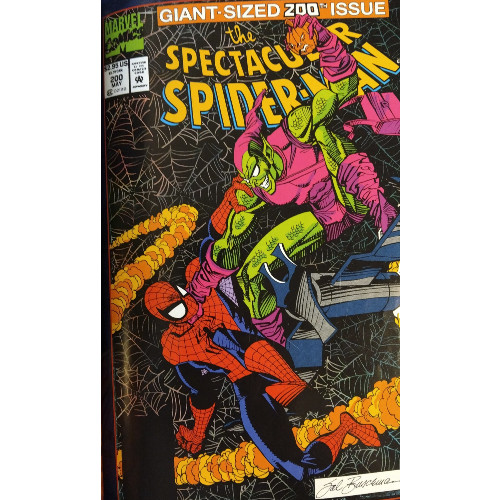
I shouldn't call this a "prelude." This is, after all, the event I've spent the last two years leading up to, chronicling (most) of the ongoing enmity between Spider and Goblin, initiated by Norman Osborn and carried on by son Harry (with a little interruption from Bart Hamilton in the middle there). I simply carry the "Prelude" part of the title to maintain consistency, but make no mistake: this is what it has all been building towards, the final showdown between Peter Parker and Harry Osborn.
It's been a complex road reaching this point, born from simple origins. The Green Goblin has gone from an unknown man faking a movie shoot to fight Spider-Man, to a wannabe crime lord, to a murderer, to a psychotic former roommate and best friend hopped up on drugs and his hype regarding his "dearly departed" father. Spidey may leave a tangled web, but the Green Goblin has left a series of crisscrossing contrails. Anger, rage, murder, betrayal, explosions, accidental deaths, addictions, kidnappings…all leading here.
This isn't the end, naturally, of the Spider/Goblin war–Norman himself would resume that rivalry a few years after this issue's publication, with the implication that, technically, it never ended. But that is for future retcons to tackle. For the purposes of this narrative, Spectacular Spider-Man #200 marks the cessation of hostilities between Spider-Man and the Green Goblin. And like with the climatic Spectacular Spider-Man #189, we have the team of J.M. DeMatteis and Sal Buscema to thank for this giant-sized anniversary issue.
I've told you before things go wrong in these Spectacular anniversary issues–like a painful breakup or wrongful imprisonment–but future writers would be hard-pressed to top what DeMatteis and Buscema provide here.
"Best of Enemies"
Writer: J.M. DeMatteis
Penciler: Sal Buscema
Inker: Sal Buscema
Colorist: Bob Sharen
Letterer: Joe Rosen
Issue: Spectacular Spider-Man #200
Publication Date: May 1993
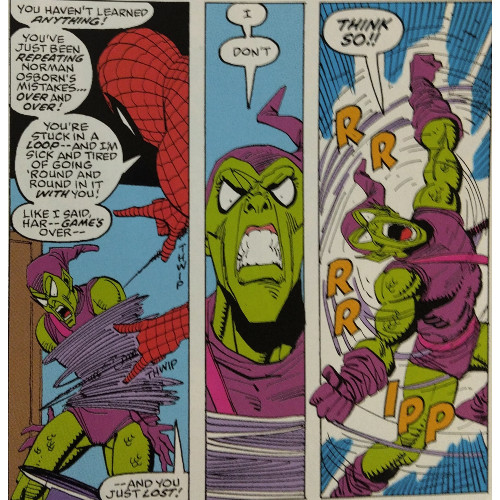
The challenge with reviewing some of these issues is that gaps exist–I have noted before I am only reviewing narratives where the Green Goblin physically appeared (save for a handful of "interlude" issues), meaning I have skirted around narratives where Harry appeared as a regular dude, except for issues I've reviewed for "Spider-view." Thus, while I am not reviewing these stories in a complete vacuum, I am leaving out some context. The same is no different for this narrative. Harry, since his last battle with Peter, has been released from police custody yet is very much sick. Fully cognizant of Peter's dual identity, Harry pulls that green mask over his face and resumes hostilities, kicking off this issue by kidnapping Mary Jane and bringing her to a special place: the bridge where Gwen died.
This scene is but one example of the challenge presented to DeMatteis and Buscema with this issue: they're not only resolving the Peter/Harry conflict but the overall Spidey/Goblin war, writing the then-final chapter for a series of escalating encounters which had been waged since 1964. Each "era" of the war, I'd argue, had definitive turning points–the first time Norman became amnesiac, the death of Gwen/the "death of Norman Osborn"–and this issue marks the end of the Harry Osborn era of the saga. But it's more than just wrapping up Harry's story; it's providing finality to the entire hateful thing. Therefore, DeMatteis and Buscema must balance providing closure for the past with leaving their own personal stamp on a narrative they have already contributed to previously.
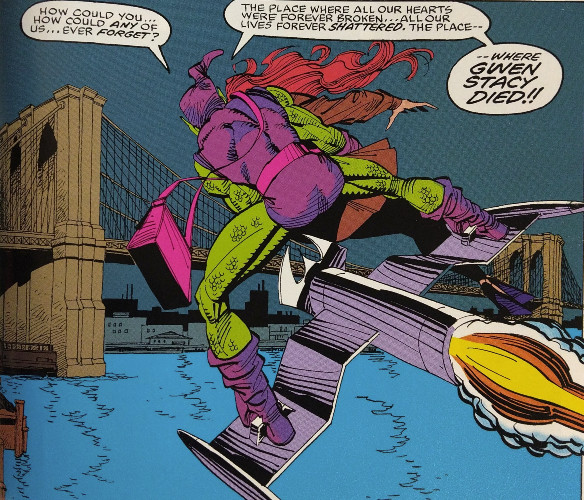
They walk the line fairly well. As I noted in my last post, DeMatteis brought Harry permanently across the "villain" line. No more pretending to be a hero, no more defending his family as a torn man. The Goblin took over, indwelt Harry, pushed him into darker territories. That aspect is maintained well here, with Harry at his most manipulative, with even seemingly kind gestures intended to push his own agenda and torment Peter. He adopts Venom's "follow Peter and torment him at every turn" strategy, hovering close when he can and being a constant nuisance (heck, Norman once applied a similar strategy, turning Peter into a nervous wreck). DeMatteis and Buscema create tension in that Harry could try and kill Peter any time he wants to but is holding out, compounding his friend's misery through mental anguish.
The whole bit is dark and frightening, and DeMatteis and Busceme tap into a psychological horror aspect which hasn't been as readily apparent in past Green Goblin stories. Harry can fly around on his glider and break into Peter's apartment, yet he can go back home and see his wife and kids–in the same building where Peter and MJ live!–and act (or try to act) like the world is normal. He stalks Peter, kidnaps MJ, accosts J. Jonah Jameson at the Daily Bugle…flaunting the control he believes he has. Imagine trying to sleep knowing your greatest enemy lives a few floors away–knowing your greatest enemy owns the apartment complex where you live–and can come and go as he pleases. And what can you do about it? Harry threatens to reveal Peter's identity to the police if the hero lays a finger on Harry. There's no safety to be found, and the stress and strain of these circumstances ratchets the reader's own anxieties as the issue develops.

But DeMatteis is a student of the past, with much of the conflict also revolving around old wounds. A standout scene between MJ and Harry on the bridge sees MJ attempt to talk Harry out of this madness, reminding him of the past, back when life was good between them, Peter, and Gwen. She draws comparisons between Peter, herself, and Harry and the familial damage done to all three of them, calling to mind the first time Peter and Harry really connected in college in ASM #39. And Harry is forever reflective of his father, wishing to build upon the Osborn name in a way Norman would be proud of, a way which seems to combine Harry's two sides, the father/husband and the supervillain. MJ hits the nail on the head when she blames Norman, in part, for bringing them to this place, despite Harry's protestations. Still on the "greatest man the world has ever known" kick, eh, Harry?
What also adds a chilling sense of menace to this issue is how well DeMatteis understands the ripple effect of this conflict. During "Kraven's Last Hunt," DeMatteis successfully divided the narrative between three characters–Spidey, MJ, and Kraven–giving them each their own thoughts, contained within different colored text boxes, showing how the events of the narrative impacted each central character. He doesn't apply that same trick here, but across this issue, we see the damage done to our main characters. MJ endeavors to logically work out the conflict, smoking cigarettes to dull the misery and arguing with Harry up until the last possible second. Normie Osborn finds himself in physical danger late in the issue and, as additional narratives will attest, is certainly damaged emotionally by the issue's events. Liz paints on a smile and denies that anything is wrong, obviously hiding the true anguish she must be experiencing. There is nice complexity woven throughout here, with the characterization trumping the action and feeling spread fairly evenly between our central and supporting cast members.
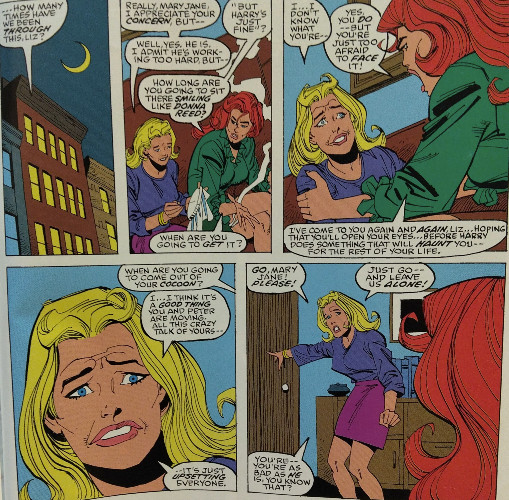
And then we get to the ending, the final fight between Spider and Goblin. Spidey fans will know this issue marks the (at the time) death of Harry Osborn, succumbing to the Goblin formula, another victim of the conflict Norman created. Like father, like son. And like his father, Harry eventually returned, but for now, his death was intended to be permanent. He dies after saving MJ, Normie, and Peter from a trap he set earlier, the Goblin formula, which had gifted him strength while also contributing to his mental decline the last several issues, taking its final toll on his body.
This is the point where I say what is certainly a controversial take: I'm torn about Harry's death.

I say "controversial," because I know several people love this issue, and they appreciate the emotions of Harry's final moments. "You're my best friend," Harry says, his final words before his death (unintentionally revealing, it's indicated, Spidey's identity to Normie). Two pages of silent panels follow that pronouncement, with Peter holding Harry's hand as he dies, the final panel switching to a photo showing Peter and Harry during friendlier times. It's absolutely touching, a fitting end for just how horribly tragic Harry's life has been until this point. You think of all Harry's been through: seeing his father die, facing his drug addiction, being kidnapped by his psycho psychologist, fighting the Hobgoblin, feeling betrayed by Peter, lapsing into this final iteration of his grim, grinning, ghoulish persona…and now he's dead. I mean "fitting" in a poetic sense, because it's not like I wanted the guy to die, but within the scope of the whole conflict and the progression of Harry's story, this feels like the most natural conclusion. And there is something to be said that Harry's death is different from Norman's–he doesn't die in battle with Spidey; he dies after saving Peter's life. There is a peace here he finds that he could never reach while he lived, a final rest.
What frustrates my own emotions towards this death is Harry's turnaround immediately preceding his passing, another single moment which causes his mind to clear, propelling him to save Spidey, MJ, and Normie from his own trap. The scene leans into the notion that Harry is a man divided, as other writers have indicated, pointing to the character's complexity. He's struggled with so many demons–both self-inflicted and inflicted upon him–that redemption feels warranted. His last action is to rescue people "non-Goblin" Harry would love, allowing "regular" Harry (how about "Norman Osborn"?) to triumph over the Green Goblin, to prove Spidey's ongoing argument that something human and caring lived behind the Goblin's cold eyes. However, there doesn't feel like enough build-up to that turnaround, leaving the moment feeling sudden.
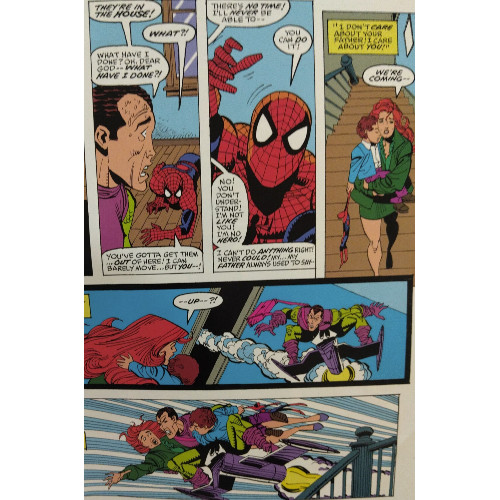
It's not completely unprompted, and this brings us back to my original comment that I am somewhat reviewing this issue in a vacuum. This review relies heavily on the past, as does DeMatteis, but it also relies on commending or critiquing the issue on its own merits. As a conclusion to all that has come before, this issue works remarkably well. I am just not a fan of DeMatteis having Harry's mind clear in what seems like a single instant. This entire issue leading up to this moment has been Harry on an emotional rampage, hounding and hunting Peter at every turn, and let's not forget similar tactics he employed against his family in SSM #189. We've seen bits of humanity–Harry's talk with MJ, for example–but each scene has convinced us that Harry and the Goblin are fully intertwined, that the struggle for dominance is finished. The Goblin has won.
For that to be undone in a singular moment feels a little cheap, and considering how well DeMatteis deals with characterization, Harry's turn towards a final, desperate act of heroism after inflicting so much suffering on his loved ones does not allow the balance I would have appreciated. If a greater struggle had been present, if we saw a side of Harry pushing against the Goblin's dominance, I would be more lenient towards that moment. But a sudden shock turn after Harry has done nothing but hurt Peter and planned to destroy the lives of several others is awkward. It makes the ending feel rushed and Harry's moment of redemption not as impactful as it could have been. A struggle would have allowed the moment to feel natural, a culmination of the smaller hints of internal combat I wish DeMatteis had provided.
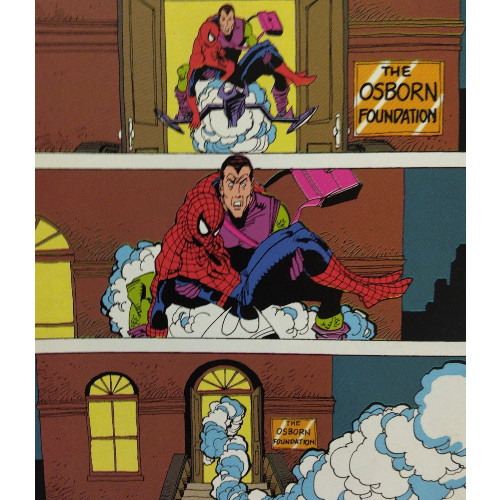
But the rest of the issue plays out nicely, DeMatteis properly weaving a chilling tale of revenge, and the ending allowing for a graceful redemption, even if the transition between the two feels rough and too spontaneous for me to laud with the rest of the narrative. You get the sense that this is where the trail the Goblin created was always going to lead, with Harry's unfortunate destruction. Blame him, blame Norman. Harry is the second dad to die in this seemingly eternal struggle, and future writers would find the grounds where he was buried ripe for stories to tell.
If this is your first "Osborn Prelude" post, I encourage you to go back and read the others. You'll find the Green Goblin's story leading up to this anniversary issue is three wild decades of comics, some more powerful than others, but each working to construct one of the most famous rivalries in all of Marvel history, if not comics overall. There is triumph and torment snaking through the entirety of it, as a father and son (and psychologist) seek to take their frustrations out on our Web-Headed Wonder. In these Harry issues, we get a lot of talk about legacy, even if it isn't always named as such. We witness the unraveling of Harry Osborn as he battles himself and an orange-hued pretender to the throne, all in the name of his twisted father, seeking to uphold a family name which may be better off buried in the dirt.
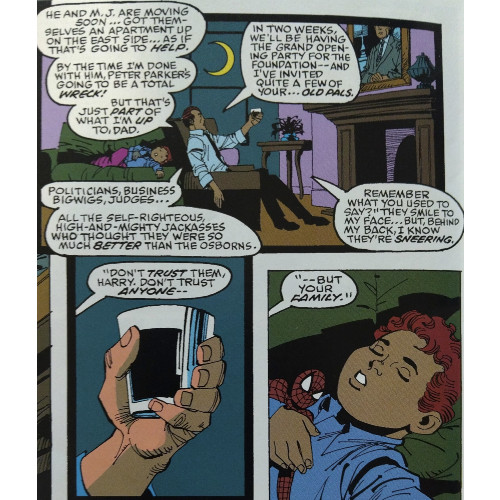
I referred to Harry as a "victim" above, and I believe that's true; he may be a victim more than he is a villain, and I feel DeMatteis and Buscema's ending is meant to showcase that idea. Within Harry Osborn, there was always the desire to be heard and seen…if not by his father, then by wife, his son, his best friends. But somewhere along the way, he couldn't accept the fact his father would never see him the way he wanted to be seen, no matter how well he conformed to his father's image for him. Even Norman's "death" couldn't unclench the ghost of his opinions from Harry's shoulders until the last moment. With Harry's "death" comes a final nail in Norman's coffin: peace between the Parkers and the Osborns (if we're not including a traumatized Normie), even if it's only a temporary development.
This hasn't been a perfect set of stories. I've had a few nitpicks here and there–Stan Lee relying too heavily on the "revolving door" plot of Norman's amnesia, a frustrating schism between Harry and Peter created by Gerry Conway in the last story I reviewed, and the bluntness of Harry's turn towards redemption here. I am certain folks would argue against my take, and that's fine. This anniversary issue is still a gripping conclusion to this "era" of Spidey/Goblin stories, and I'm glad to have finally reached this point. This review has been two years in the making, and despite a complaint regarding a handful of panels, I'm glad this issue is as strong as it is.
Cause knowing where we're going…things are going to get worse.